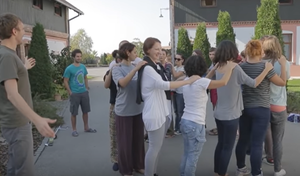Where do you stand?
PREPARATION
Whatever the topics to be discussed, various judgment sentences are created within the scope of that topic. These judgment sentences should be controversial sentences that people will have difficulty deciding whether to agree or disagree with. See the last section for example sentences. If there is a projector and a screen, these sentences are written one by one on each slide. If there is no projector, they can also be written on large poster paper. Then the hall is divided in two according to the width and length of the hall. On one side a paper with YES written on it is placed and on the other side a paper with NO written on it is placed. A line is drawn EXACTLY IN THE MIDDLE of each side. This is the zero point.
INTRODUCTION
Friends, we are going to play a discussion game. I will show you some judgment sentences in turn. I will ask you to move to the YES section if you agree with the sentence you see and to the NO section if you disagree. After seeing each sentence, you will have 30 seconds to think and decide. At the end of the time you will have to choose a side. This whole exercise will be done in silence.
No talking will be allowed until everyone has chosen a side and the discussion starts.
APPLICATION
Only show each sentence of judgment. Never read it. Because even while reading, you can add your own interpretation with your intonation.
As a moderator, try to stand at ground zero with as neutral a facial expression as possible.
Have a microphone or a representative microphone (pen) in your hand. During the discussion, give the microphone to those who want to speak and make sure that the speaking time is equal.
During the discussion, allow participants to change their minds if they wish.
remind them that they can change their position.
In one version of the app, they can only take a position based on yes and no, while in other variations they can also take a position based on agree and disagree. You can decide whether to let undecided participants stay in the middle or to force them to choose a side in any case.
ANALYSIS AND EVALUATION
Remind them that there is never right and wrong in all these judgmental statements, and that everyone approaches from their own perspective.
You can ask whether they gained new perspectives during the discussions.
According to your training topic, you can share conceptual knowledge about the relevant concepts after the evaluation.
SAMPLE JUDGMENT SENTENCES
1. Volunteering is done without expecting anything in return.
2. Volunteering is a good deed.
3. Military service is a voluntary service.
4. Democracy is the dictatorship of the majority.
5. Every community needs a higher identity.
6. Culture is artificial.
Method Details
Added by
Contact with the Author
Where do you stand? 0 reviews
Login to Write Your ReviewThere are no reviews yet.
Write Your Review
Related Listings

-
In Person Training
-
This exercise can be carried out individually or in small groups of 3 to 4 people.
-
15-20 min













